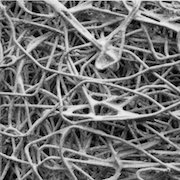There are musicians whose work does not see the light of day, for reasons – aesthetic, commercial, or otherwise – that are hard to fathom. There are countless other musicians whose work remains locked away, awaiting discovery. And there are musicians whose work remains so deep seated within them that to release it is a struggle in and of itself. From Elevated Gangways Rivers of Molten Metal Flow by Hwyl Nofio is one such example.
The man behind Hwyl Nofio (roughly translated to mean ‘emotional swimmers’) is Steve Parry, a classically trained guitarist who has spent over thirty years making experimental music, at times in collaboration with the likes of Mark Beazley (Rothko), Frederik Soegaard and the mysterious Oedipus Sisters. Albums such as The Singers and Harp Players Are Dumb, Hymnal and Hounded by Fury are brooding and immersive, emphasizing guitar-based experimentalism and tonal composition. But From Elevated Gangways… is another step forward: an intensely personal project, centred on his grandfather Herbert Parry, who once worked in the Panteg Steel Works in Pontypool, South Wales. The vast structure, which once measured a mile long from end to end, has now vanished from the landscape of that area. This album summons that place, and the memory of those that toiled there, back from the dead.
The use of industrialization as a direct subject has a long and illustrious history in British music, and From Elevated Gangways… is a bruising and accusatory addition to that lineage. The album itself is something that was once forged, torn down and forged again anew over successive decades. An accompanying essay details the transformations that album went through, from 12-minute segment to a 41-minute-plus full-length of visceral guitar noise. The release of From Elevated Gangways brings this behemoth to its final incarnation, and epic split into two parts that roars and rails with clattering abandon. Slashing cymbals break under the weight of a piercing, all-encompassing guitar drone that crosses over from modern composition into the atavistic realms of doom. This is a sound with which to blot out the sun. A sound of violence, of human strength brought low, of an inferno.
That sound hollows out into a baleful church organ drone, an unexpected diversion but one that corresponds to the landscape of South Wales, and the place of the church within it as a place of consolation and of creativity. That glowering guitar drone recurs in the second half of the album, drowning everything beneath it in a mighty arc of noise, before it fades, giving way to dolorous cello drags and sinister field recordings. Available as a limited signed art book of just 100 copies and as a download, this is a long lost project brought to fruition, ready to see the light of day.


